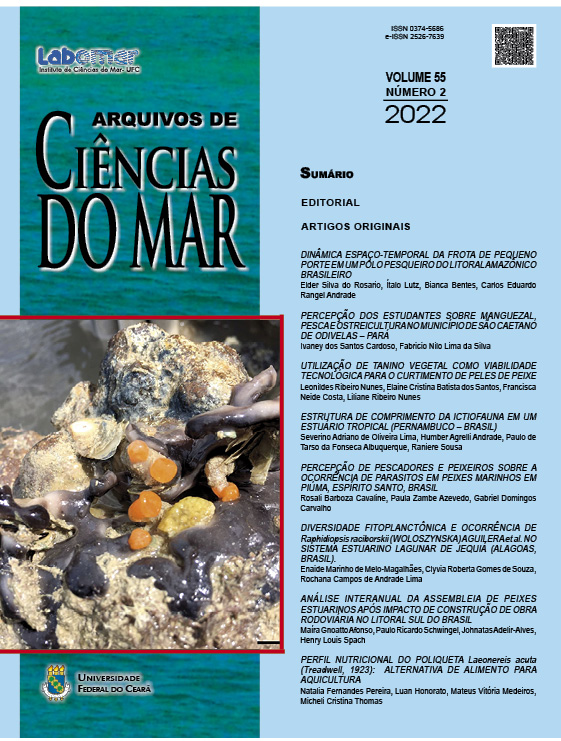DIVERSIDADE FITOPLANCTÔNICA E OCORRÊNCIA DE Raphidiopsis raciborskii (WOLOSZYNSKA) NO SISTEMA ESTUARINO LAGUNAR DE JEQUIÁ (ALAGOAS, BRASIL)
DOI:
https://doi.org/10.32360/acmar.v55i2.61433Resumo
A Laguna de Jequiá é considerada a terceira maior do estado de Alagoas e está situada entre as coordenadas geográficas 9°50’-10°50’ S e 36°00’-36°10’ W. O presente estudo objetiva contribuir para o conhecimento da microflora planctônica, abordando os aspectos qualitativos e quantitativos, além de verificar a ocorrência de cianobactéria potencialmente tóxica no Sistema Estuarino Lagunar de Jequiá da Praia. Amostras para análises qualitativa e quantitativa foram coletadas em outubro e dezembro de 2019 em quatro estações de coletas. Para quantificação do fitoplâncton, as amostras foram coletadas diretamente da subsuperfície da água e fixadas com lugol. Para o estudo qualitativo, as amostras foram obtidas utilizando-se rede de plâncton com malha de 25 µm e fixadas com formol neutro a 4%. Foram identificados 72 táxons, representados principalmente por espécies de origem dulciaquícolas, destacando-se em termos qualitativos os grupos Heterokontophyta, Cyanophyta e Chlorophyta. Os valores da densidade fitoplanctônica total estiveram entre
37.560 e 146.800 Org.mL-1. A cianobactéria Raphidiopsis raciborskii (Woloszynska) foi considerada muito frequente e dominante em todas as estações de coletas, com densidades variando entre 28.140 Org.mL-1 e 142.720 Org.mL-1. A dominância da cianobactéria R. raciborskii contribuiu para os baixos valores da diversidade e equitabilidade do fitoplâncton nas estações de amostragem.
Palavras-chave: estuário, plâncton, ecologia, ecossistema tropical.
Downloads
Downloads
Publicado
Como Citar
Edição
Seção
Licença
Copyright (c) 2023 Arquivos de Ciências do Mar

Este trabalho está licenciado sob uma licença Creative Commons Attribution 4.0 International License.
1. Proposta de Política para Periódicos de Acesso Livre
Autores que publicam nesta revista concordam com os seguintes termos:
- Autores mantém os direitos autorais e concedem à revista o direito de primeira publicação, com o trabalho simultaneamente licenciado sob a Licença Creative Commons Attribution que permite o compartilhamento do trabalho com reconhecimento da autoria e publicação inicial nesta revista.
- Autores têm autorização para assumir contratos adicionais separadamente, para distribuição não-exclusiva da versão do trabalho publicada nesta revista (ex.: publicar em repositório institucional ou como capítulo de livro), com reconhecimento de autoria e publicação inicial nesta revista.
- Autores têm permissão e são estimulados a publicar e distribuir seu trabalho online (ex.: em repositórios institucionais ou na sua página pessoal) a qualquer ponto antes ou durante o processo editorial, já que isso pode gerar alterações produtivas, bem como aumentar o impacto e a citação do trabalho publicado (Veja O Efeito do Acesso Livre).

